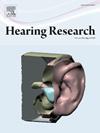代谢组学在获得性听力损失中的应用:进展与系统综述
IF 2.5
2区 医学
Q1 AUDIOLOGY & SPEECH-LANGUAGE PATHOLOGY
引用次数: 0
摘要
听力损失是一项重大的全球公共卫生挑战,严重危害身心健康。代谢组学作为一种新兴的组学技术,反映了受遗传和环境因素影响的代谢状态,在听力损失研究中得到越来越多的应用。本文综述了代谢组学在几种类型的获得性听力损失中应用的最新进展,包括年龄相关性听力损失、噪声性听力损失和突发性感音神经性听力损失。代谢组学通过对内耳组织、淋巴管周围和血浆等样本中差异表达代谢物的鉴定和功能富集,旨在探索获得性听力损失的发病机制,识别诊断和预后的生物标志物,为新的治疗方法提供了广阔的前景。我们从现有研究中收集的证据表明,代谢组学途径(如氨基酸代谢、脂质代谢、嘌呤和嘧啶代谢以及自噬)与获得性听力损失之间存在潜在的相关性。像鞘氨醇这样的生物标志物也显示出它们预测其诊断和预后的潜力。最后,我们强调了标准化实验设计和扩大样本量以提高代谢组学结果的准确性和可比性的重要性。将代谢组学与多技术、多维信息相结合,促进临床转化,可能是该领域未来的发展方向。本文章由计算机程序翻译,如有差异,请以英文原文为准。
Application of metabolomics to acquired hearing loss: Advances and systematic review
Hearing loss poses a significant global public health challenge, seriously jeopardizing both physical and mental health. As an emerging omics technique, metabolomics reflects the metabolic state influenced by both genetic and environmental factors and has been increasingly applied to hearing loss research. This review summarizes the latest advances in metabolomics applied to several types of acquired hearing loss, including age-related hearing loss, noise-induced hearing loss, and sudden sensorineural hearing loss. Through the identification and functional enrichment of differentially expressed metabolites in samples such as inner ear tissues, perilymph, and plasma, metabolomics aims to explore the pathogenesis and identify diagnostic and prognostic biomarkers of acquired hearing loss, providing promising prospects for novel treatments. Evidence we gather from existing studies suggests potential correlations of metabolomic pathways—such as amino acid metabolism, lipid metabolism, purine and pyrimidine metabolism, and autophagy— with acquired hearing loss. Biomarkers like sphingosine also show their potential to predict its diagnosis and prognosis. Finally, we highlight the importance of standardizing the experimental design and expanding the sample size to enhance the accuracy and comparability of metabolomics results. Integration of metabolomics with multiple techniques and multidimensional information, as well as promotion of clinical transformation may be the future developmental direction in this field.
求助全文
通过发布文献求助,成功后即可免费获取论文全文。
去求助
来源期刊

Hearing Research
医学-耳鼻喉科学
CiteScore
5.30
自引率
14.30%
发文量
163
审稿时长
75 days
期刊介绍:
The aim of the journal is to provide a forum for papers concerned with basic peripheral and central auditory mechanisms. Emphasis is on experimental and clinical studies, but theoretical and methodological papers will also be considered. The journal publishes original research papers, review and mini- review articles, rapid communications, method/protocol and perspective articles.
Papers submitted should deal with auditory anatomy, physiology, psychophysics, imaging, modeling and behavioural studies in animals and humans, as well as hearing aids and cochlear implants. Papers dealing with the vestibular system are also considered for publication. Papers on comparative aspects of hearing and on effects of drugs and environmental contaminants on hearing function will also be considered. Clinical papers will be accepted when they contribute to the understanding of normal and pathological hearing functions.
 求助内容:
求助内容: 应助结果提醒方式:
应助结果提醒方式:


